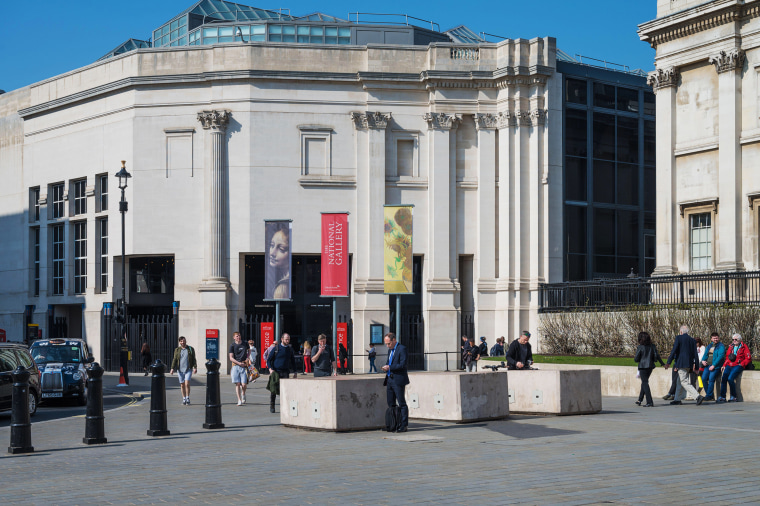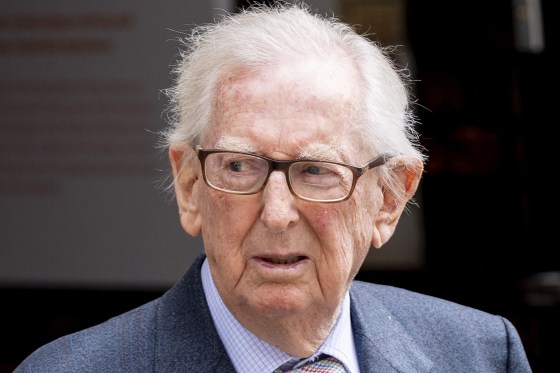LONDON — What does a billionaire philanthropist do when the art gallery he is sponsoring builds some pillars he doesn’t like? The answer, it turns out, is to have the last say from beyond the grave almost a quarter of a century later.
In the 1980s, British grocery store magnate Lord John Sainsbury, Baron of Preston Candover, spent tens of millions funding a new wing of London’s National Gallery. He did not like one aspect of the design, however: two nonstructural, false columns in the building’s lobby.
Whereas a pushy American tycoon might have dug their heels in, Sainsbury, of the giant British superstore chain Sainsbury's, took the kind of audacious I-told-you-so approach that perhaps only a politely outraged Brit could pull off.
It was revealed this week that, during a refurbishment, construction workers demolishing the columns found a note Sainsbury had hidden inside one of them while it was being built in 1990.
“IF YOU HAVE FOUND THIS NOTE YOU MUST BE ENGAGED IN DEMOLISHING ONE OF THE FALSE COLUMNS THAT HAVE BEEN PLACED IN THE FOYER OF THE SAINSBURY WING OF THE NATIONAL GALLERY,” read the missive, printed on official Sainsbury's superstore letterhead paper. “I BELIEVE THAT THE FALSE COLUMNS ARE A MISTAKE OF THE ARCHITECT AND THAT WE WOULD LIVE TO REGRET OUR ACCEPTING THIS DETAIL OF HIS DESIGN.”
He added, “LET IT BE KNOWN THAT ONE OF THE DONORS OF THIS BUILDING IS ABSOLUTELY DELIGHTED THAT YOUR GENERATION HAS DECIDED TO DISPENSE WITH THE UNNECESSARY COLUMNS.”
The note was discovered last year but only reported this week in monthly publication The Art Newspaper. The details of the story were confirmed to NBC News on Wednesday by the Sainsbury Family Charitable Trusts.

John Sainsbury died at age 94 in 2022 and therefore never saw his note resurface. His widow, Lady Sainsbury, a former ballerina named Anya Linden, 91, told The Art Newspaper that she was “so happy for John’s letter to be rediscovered after all these years.”
Sainsbury was a key player in building his family’s grocery store dynasty. Sainsbury’s launched in 1869 and, largely thanks to his 23-year leadership, between 1969 and 1992, has become the United Kingdom’s second-largest supermarket chain.
According to The Sunday Times Rich List in 2008, the family’s net worth was 1.3 billion pounds (around $1.7 billion). Among some 300 million pounds of charitable trusts, he and his family donated a reported 40 million to the building of the National Gallery’s Sainsbury Wing.
The addition to the gallery, which was founded in 1824, has always been controversial. The original designs were criticized by King Charles III, then the Prince of Wales, as “a carbuncle on the face of a much-loved friend” — one of his famous forays into the world of architectural critique.
The plans were ditched and replaced with new ones, which included the false columns at the center of this week’s revelations. They have been removed as part of an 85 million-pound upgrade to the gallery designed to give the lobby more space for visitors.
Sainsbury’s widow told The Art Newspaper that “he would be relieved and delighted for the gallery’s new plans and the extra space they are creating.”

